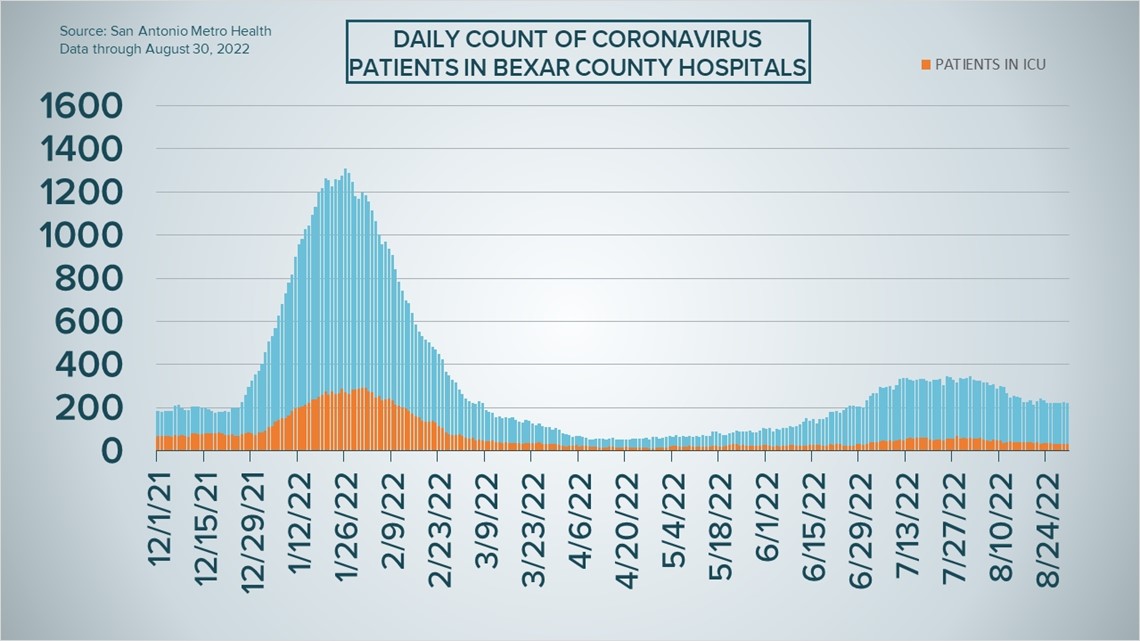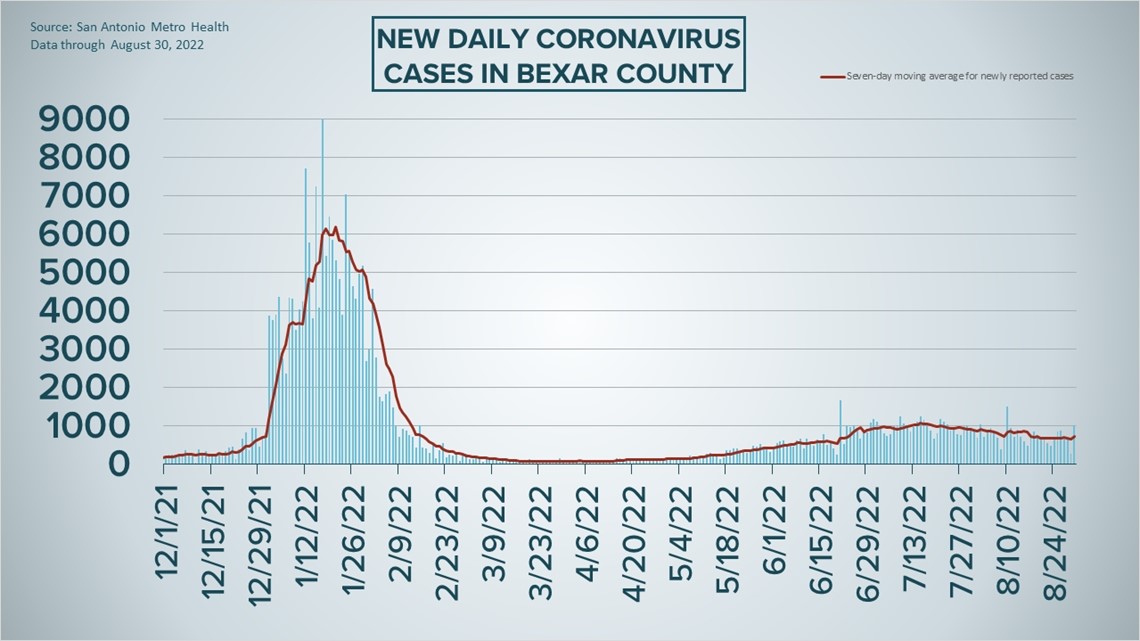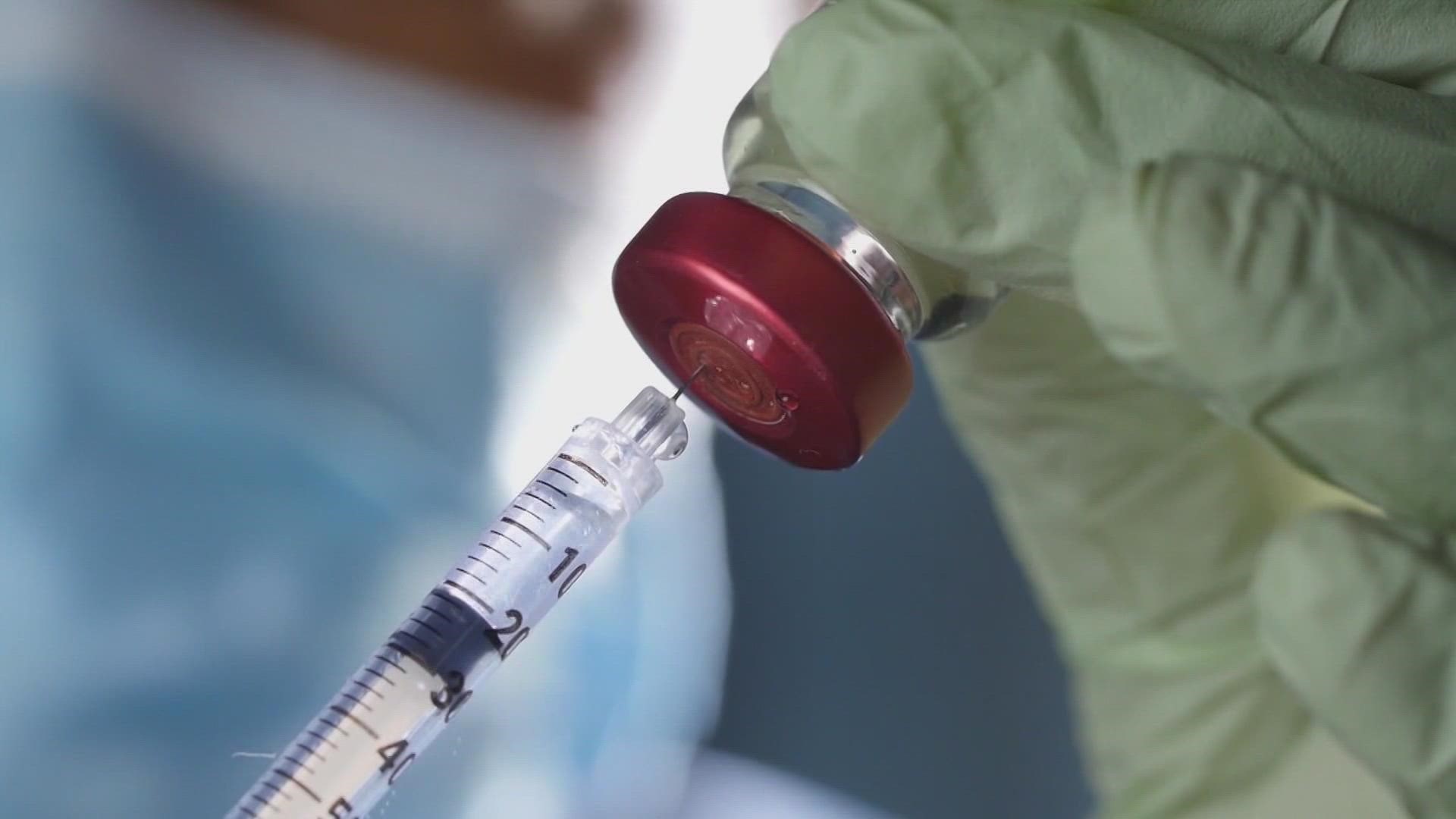SAN ANTONIO — San Antonio's first daily COVID-19 case count of at least 1,000 since August 10 – and just the third overall this month – caused the region's seven-day case average to jump to 717, up from 642 on Monday.
A total of 1,006 new infections were reported by health authorities Tuesday, a rare high tally for a month that otherwise saw smaller case counts and fewer coronavirus patients in hospitals as the community recovered from a July wave. Bexar County is still poised to see its first month-to-month drop in daily case counts since February flipped to March; 738 cases were reported daily on average in August, down from 961 in July.
Metro Health's local risk level indicator remained in the high threshold but now says the risk of virus transmission is "steady" instead of "improving," which it had been for the past week.
Officials also continue to emphasize vaccination as kids return to school.
Hospitalizations, however, continue to decline. On Tuesday there were 221 patients receiving treatment in local facilities, down 13 from this time last week and down 36% overall since August 1. Of those 221, 31 are in intensive care and six are using ventilators.
No new virus-related deaths have been reported since last Thursday. The local death toll remains at 5,355, while nearly 628,000 infections have been reported locally.
How Bexar County is trending




Vaccine progress in Bexar County
The following numbers are provided by San Antonio Metro Health. A full breakdown can be found here.
- 1,469,265 eligible Bexar County residents are fully vaccinated as of August 15, which is about 77.2% of the total population over the age of 4.
- 574,458 eligible Bexar County residents have received a COVID-19 booster shot as of August 15, which is 39.9% percent of the population.
The CDC states that "when a high percentage of the community is immune to a disease (through vaccination and/or prior illness)," that community will have reached herd immunity, "making the spread of this disease from person to person unlikely."
The City of San Antonio breaks down the vaccination rates by zip code on Metro Health's Vaccination Statistics page.
Coronavirus in Texas
The total number of coronavirus cases in the state grew by 11,177 on Tuesday, according to the Texas Department of State Health Services. That total includes 6,606 new confirmed cases and 4,571 new probable cases. More details can be found on this page.
Tuesday's figures bring the total number of Texans diagnosed with COVID-19 to more than 7.72 million.
An additional 43 Texans have died from virus complications, the state reported Wednesday, raising the statewide death toll to 88,578.
Coronavirus symptoms
The symptoms of coronavirus can be similar to the flu or a bad cold. Symptoms include fever or chills, cough, shortness of breath or difficulty breathing, fatigue, muscle or body aches, headache, new loss of taste or smell sore throat, congestion or runny nose, nausea or vomiting, and diarrhea, according to the Centers for Disease Control.
Most healthy people will have mild symptoms. A study of more than 72,000 patients by the Centers for Disease Control in China showed 80 percent of the cases there were mild.
But infections can cause pneumonia, severe acute respiratory syndrome, kidney failure, and even death, according to the World Health Organization. Older people with underlying health conditions are most at risk.
Experts determined there was consistent evidence these conditions increase a person's risk, regardless of age:
- Chronic kidney disease
- COPD (chronic obstructive pulmonary disease)
- Obesity (BMI of 30 or higher)
- Immunocompromised state (weakened immune system) from solid organ transplant
- Serious heart conditions, such as heart failure, coronary artery disease, or cardiomyopathies
- Sickle cell disease
- Type 2 diabetes
- The CDC believes symptoms may appear anywhere from two to 14 days after being exposed.
Human coronaviruses are usually spread...
- Between people who are in close contact with one another (within about 6 feet).
- Through respiratory droplets produced when an infected person coughs, sneezes or talks. These droplets can land in the mouths or noses of people who are nearby or possibly be inhaled into the lungs.
- Some recent studies have suggested that COVID-19 may be spread by people who are not showing symptoms.
Help stop the spread of coronavirus
- Stay home when you are sick.
- Eat and sleep separately from your family members
- Use different utensils and dishes
- Cover your cough or sneeze with your arm, not your hand.
- If you use a tissue, throw it in the trash.
Find a testing location
City officials recommend getting a COVID-19 test if you experience fever or chills, cough, shortness of breath or difficulty breathing, fatigue, muscle or body aches, headache, new loss of taste or smell, sore throat, congestion or runny nose, nausea or vomiting, or diarrhea.
Here's a Testing Sites Locator to help you find the testing location closest to you in San Antonio.
Latest Coronavirus Headlines
- Jill Biden tests negative for COVID after rebound case
- Government to pause free COVID test orders soon
- Moderna plans to sue Pfizer for patent infringement over COVID-19 vaccine technology
- Austin clinic helping COVID-19 long-haulers by using regenerative therapy
- Updated COVID boosters are close. But how much will they help?
- Study: Pfizer COVID pill showed no benefit in younger adults
- COVID vaccines for fall: Pfizer seeks OK of updated boosters

